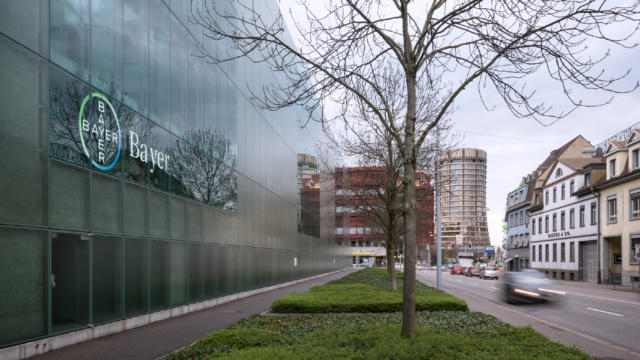Not long ago, preparing for quarterly and annual planning conferences at global life sciences company Bayer was a multi-step process for the Corporate Controlling team: They would gather information from divisional, functional, and corporate planning systems and calculate further KPIs, rationalize the data, put it in a consistent visual format, and produce a “pre-read” book for the Board of Management and senior managers attending the planning conferences. “The book was signed by the head of controlling—with a pen,” recalls Philipp Ahrendt, Head of Financial Modeling and Analytics in Bayer’s Corporate Controlling. “The process took five to six days, and if something changed during that time, we had to start all over again. But things are different now. We presented our financials live in the system for the first time mid-2020, and as of 2021, all planning conferences are conducted this way.”
The discussions are now being facilitated using Anaplan, and during the meetings, the head of controlling uses Anaplan dashboards to guide the attendees through the financials and potential scenarios. This is a huge step forward for Bayer’s digital agenda. The switch from printed, autographed books to digital solutions based on Anaplan technology symbolizes Bayer’s transformed planning and decision-making process and demonstrates how Corporate Controlling has evolved to positively influence the company’s digitization strategy.
Looking for agility and sustainability in Corporate Controlling
Bayer, a $51 billion company headquartered in Germany, has a history of innovation dating back to its founding in 1863. Its three divisions — Pharmaceuticals, Consumer Health, and Crop Science — each do their financial planning in a group-wide harmonized SAP planning system. “Our divisions plan at different levels of granularity due to the nature of their businesses,” Ahrendt explains. “However, as the Corporate Controlling team supports all financial planning processes that include all Bayer divisions and functions, the divisional plans need to be consolidated and harmonized to create a consistent picture.”
Those processes include the annual Operational Planning Conference (OPC), at which Bayer plans for the coming year and sets its three-year financial outlook; an annual Strategic Conference (StraCo) that generates a 10-year plan and analyzes investments, divestments, mergers, acquisitions, and other strategic options; and Quarterly Business Reviews (QBRs). For each of these processes, the Controlling staff used to perform extensive manual preparation, much of it in spreadsheets and presentation tools. “We needed a more agile, efficient and sustainable solution,” Ahrendt says.
Building a fully integrated financial model
The Controlling team first sought a solution for long-term financial planning (the StraCo) but soon realized that one system, intelligently designed and deployed, could support all corporate-level financial planning events. There were numerous requirements for the new tool. As the data would be loaded from the group-wide planning and reporting system with different levels of granularity, the new tool needed to be flexible in structure and connectable to SAP databases. To be able to cope with changing demands, the tool should not need dedicated support from outside the Controlling team; being self-sufficient would significantly increase agility. Furthermore, numbers and their connection to underlying assumptions should be transparent, so that instead of simply consolidating divisional plans, simulating group business cases through scenarios and sensitivities would be enabled.
“We needed to build a fully integrated financial model, where everything is connected,” Ahrendt states. “One where we can enter a 1% volume increase and immediately see the impact on the sales, cost of goods sold, cash flow, and net debt.”
Near the end of 2019, Ahrendt and the project team worked with Anaplan to build a proof of concept. After it was shared, the rest of the Controlling team was immediately sold. The team was able to quickly jump on the Anaplan modeling approach and created the first usable models within one week.
As of today, Bayer’s Corporate Controlling team runs several financial models in Anaplan. These models share the same calculation logic but have different time horizons; they support all planning processes from quarterly forecasts in the QBR to 10-year outlooks in the StraCo. For each process, a dedicated app has been built on top of the models to enable discussions and decision-making in the meetings.
The apps share common navigation principles and relevant group-level KPIs such as net sales, EBITDA, free cash flow, earnings per share, and net debt. “The full financial picture is always available in Anaplan in an appealing interface,” Ahrendt notes.
Scenarios and sensitivities—“where the magic happens,” as Ahrendt says—are key elements of Bayer’s financial models. Users can simulate entire business cases by activating and deactivating scenarios or adjusting sensitivities. Thanks to the digital solution, the financial effect of the altered assumptions immediately becomes visible in all KPIs.
Anaplan’s simulation power is especially useful in the StraCo meeting, where the Board of Management discusses potential mergers, acquisitions, investments, and divestments. “In the past, people presented fully calculated proposals in the StraCo meeting,” Ahrendt recalls. “If somebody asked about a different deal structure or price, the presenter had to recalculate the effects, and was only be able to give an answer after the meeting. Now we change the numbers in Anaplan and see the financial impact on our business in less than a minute.”
Efficiency, empowerment, and confidence
For Corporate Controlling, the most obvious benefit of the new solution is faster preparation of materials for planning processes. “Tasks that used to take five to six days, back when the output was still a physical book, can now be completed in about three days,” Ahrendt mentions. By eliminating manual efforts in data collection and aggregation, the team gains time for qualitative analysis and to prepare the storyline for the presentations.
Beyond efficiency, the team’s interactive models are a far superior product that encourages exploration and discussion. This advantage has been noticed at the highest levels of Bayer’s leadership. “It’s a huge step to give a digital presentation via Anaplan to all the board members,” Ahrendt says. “We received the feedback from our CFO that they have better discussions, and they make better decisions, because people immediately know the financial impact of their choices.” These faster, more confident responses to changing business conditions are a direct result of the trust generated by the transparency of the numbers and the underlying assumptions.
The new solution has also increased confidence in the Corporate Controlling team itself. “Everybody was able to quickly get a handle on Anaplan and experience success,” Ahrendt concludes. “We felt empowered, and seeing the creativity of our colleagues was quite amazing. We are a small team, but with our financial models in Anaplan, we have a big impact.”





